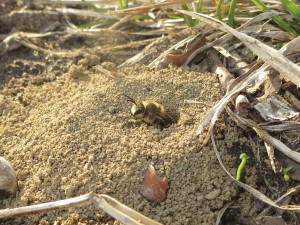It’s time to revisit my 2015 post about ground bees. That entry was intended to help people understand the critter in their yard, but people want to know – what can I do about them?

Recommendation 1: Let them Bee.
Ground bees are not like the common honey bee, nor are they similar to yellowjackets. Instead, ground bees are solitary, meaning that each hole is occupied by only one female bee and her offspring. Why does this matter? This difference in life history means that female ground bees do not have to ‘defend the nest,’ and are therefore not aggressive. According to the literature, they only sting when held. In fact, if you stand near a burrow entrance, female bees will retreat and hide in the burrow. The bees flying around at ground level are the males, who are looking to mate with females in the burrow, and do not have a stinger. I have observed ground bees very closely, and have never been stung. Ground bees are one of the first pollinators to emergence in the spring, and are only active for a few weeks. Because of this, the first recommendation is to let them run their course each spring – an important consideration due to declines in native bee populations.

Recommendation 2: Discourage their Bee-havior.
Let’s take a step back. Why are ground bees in your yard to begin with? It has to do with your lawn! Ground bees burrow in areas with exposed soil and sparse vegetation. A long-term solution to ground bees, then, is to make your yard less hospitable. You can do this by growing dense turf, following suggestions on the Cornell Turfgrass website. Dense grass and roots prevent bees from accessing the soil and digging new burrows. Keep in mind that this long-term solution will take time to implement and to impact the population.
Recommendation 3: Murder them.
Dramatic? Maybe. But having lived with ground bees for several years, I don’t see any reason to outright kill them. If you go this route, there are a few things you should keep in mind:
- Treatment can be expensive. Ground bees are not covered under most annual contracts, making this a special service. Each burrow must be treated with an appropriately-labeled product, making it labor intensive. Be sure to ask for an estimate before hiring a company for the service.
- Following treatment, children and pets should avoid that part of the yard if residual insecticides are used.
- Pesticide treatment is a short-term solution. After treatment, the bees preferred habitat remains and a colonizing bee can arrive next year and build a new burrow. If you pay for treatment, definitely take steps to discourage future populations, or be prepared to treat the same issue multiple times.
True that not everyone appreciates insects the way I do. But, taking time to observe these docile and ecologically important bees can ignite a fascination with their tiny world. For, “In all things of nature there is something of the marvelous.” -Aristotle
For more information:
Visit the Cornell University Department of Entomology’s page on native bees t learn more about ground bees in natural systems https://entomology.cals.cornell.edu/extension/wild-pollinators/native-bees-your-backyard
